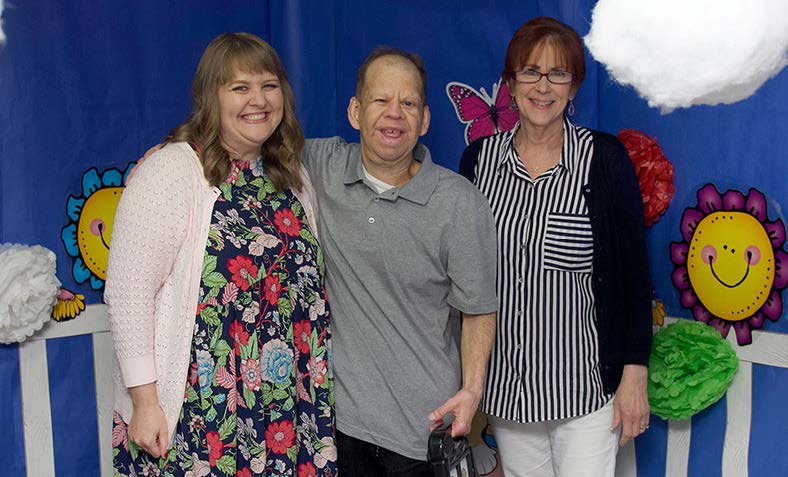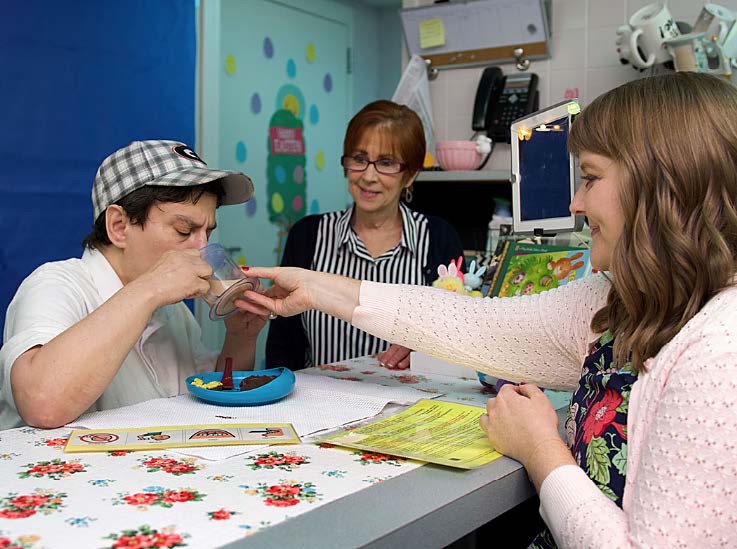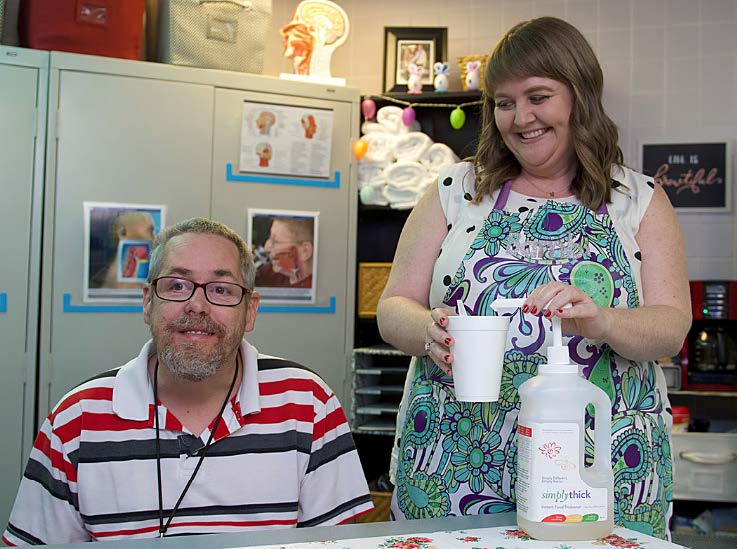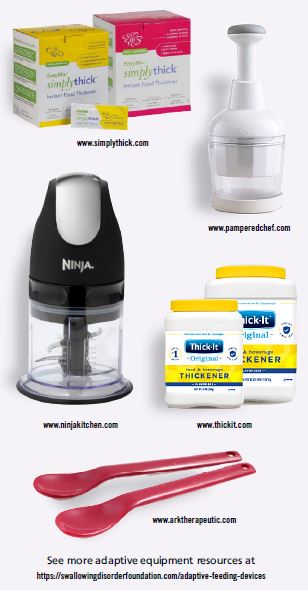
NOURISHING RELATIONSHIPS: Bambi L. Troxell, MCD/CCC-SLP (left) and Missy Lewis (right) visit with a patient at the Orange Grove Center. Several of their patients are residents of our Supportive Living or Residential programs and have been a part of OGC for most of their lives.
DYSPHAGIA DOES NOT HAVE TO BE A HARD DIAGNOSIS TO SWALLOW
AN OVERVIEW OF DYSPHAGIA IN PATIENTS WITH INTELLECTUAL DISABILITY/DEVELOPMENTAL DISABILITY
BY MISSY LEWIS AND BAMBI L. TROXELL, MCD/CCC-SLP
The most frequently asked question in the Orange Grove Center (OGC) Speech/Language/ Swallowing Department is "Can I have some coffee?" We know how all of our patients like their coffee and what their favorite snacks are, too.
Having a special treat and time with friends is something our patients look forward to. Mealtime is a social time and it is meant to be enjoyable; everyone has different preferences when it comes to what they enjoy eating/drinking.
Humans swallow between 500-700 times a day, around three times an hour during sleep, once per minute while awake and even more during meals.1 What happens when swallowing is difficult to accomplish?
• Difficulty swallowing (dysphagia) means it takes more time and effort to move food or liquid from your mouth to your stomach.
• Aspiration occurs when a person accidentally inhales particles into their airway. In the ID/DD population, those particles are most commonly foods, beverages, or bodily fluids such as saliva or vomit. Aspiration is a major medical concern because it may lead to pneumonia, infection, pulmonary edema or other issues.
• Choking (asphyxiation) occurs when the airway is blocked by food, drink, or foreign objects. Any choking incident can put someone at a risk for aspirating.
When aspiration occurs, many people with ID/DD have difficulty identifying or reporting symptoms. Signs that aspiration has happened may not be visible until after the fact and may appear to be unrelated, so it often goes undetected. Repeated trace amounts of aspiration over a long period of time can cause serious respiratory complications and permanent damage to the lungs.
In addition, dehydration, constipation, aspiration and seizures make up the "Fatal Four." These conditions have the potential to severely impact a person's quality of life and, in some cases, can be deadly.6 All individuals that receive services through Orange Grove Center have an Intellectual Disability/Developmental Disability (ID/DD), a diagnosis that can be paired with additional contraindicating congenital conditions. According to the TN Department of Intellectual and Developmental Disabilities, these co-committing disorders can lend to the following medical and behavioral factors make an individual more likely to choke or aspirate include:
• Dysphagia
• Difficulty (or absence of) chewing
• Vomiting after meals
• Throwing head back to swallow
• Difficulty controlling head or neck muscles
• Mobility limitations that prevent sitting up straight
• Impaired consciousness or awareness
• GERD (Gastroesophageal Reflux Disease)
• Eating too quickly or putting too much food in one's mouth
• Dental problems that prevent adequate chewing
• Anatomical variation such as a small airway or a large tongue
• Having pain while swallowing
(odynophagia)
• Being unable to swallow
• Having the sensation of food getting stuck in your throat or chest or behind your breastbone (sternum)
• Drooling
• Being hoarse
• Bringing food back up (regurgitation)
• Unexpectedly losing weight
• Coughing or gagging when swallowing
ANOTHER BITE : ADDITIONAL ROLES FOR SPEECH LANGUAGE PATHOLOGISTS
• Identifying the signs and symptoms of dysphagia
• Identifying normal and abnormal swallowing anatomy and physiology
• Identifying indications and contraindications specific to each patient for various non-instrumental and instrumental assessment procedures
• Identifying signs of potential disorders in the upper aerodigestive tract and making referrals to appropriate medical personnel
• Performing, analyzing, and integrating information from non-instrumental and instrumental assessments of swallow function collaboratively with medical professionals, as appropriate
• Providing safe and effective treatment for swallowing disorders, documenting progress, and determining appropriate dismissal criteria
• Identifying normal and abnormal swallowing anatomy and physiology
• Identifying indications and contraindications specific to each patient for various non-instrumental and instrumental assessment procedures
• Identifying signs of potential disorders in the upper aerodigestive tract and making referrals to appropriate medical personnel
• Performing, analyzing, and integrating information from non-instrumental and instrumental assessments of swallow function collaboratively with medical professionals, as appropriate
• Providing safe and effective treatment for swallowing disorders,
• Identifying and using appropriate functional outcome measures
• Understanding a variety of medical diagnoses and their potential impact(s) on swallowing
• Awareness of typical age-related changes in swallow function
• Providing education and counseling to individuals and caregivers
• Incorporating the client's/patient's dietary preferences and cultural practices as they relate to food choices during evaluation and treatment services
• Respecting issues related to quality of life for individuals and/or caregivers
• Practicing interprofessional collaboration as an integral part of the patient's medical care team
• Educating other professionals on the needs of individuals with swallowing and feeding disorders and the SLP's role in the diagnosis and management of swallowing and feeding disorders
• Advocating for services for individuals with swallowing and feeding disorders
• Advancing the knowledge base through research activities
• Maintaining competency of skills through reading current research and engaging in continuing education activities
• Determining the safety and effectiveness of current nutritional intake (e.g., positioning, feeding dependency, environment, diet modification, compensations).5
• Having to cut food into smaller pieces or avoiding certain foods because of trouble swallowing
• Eating non-edible objects
• Hoarding foods for later consumption
• Taking foods when no one is watching
• Quickly grabbing food from plates or counters

COMMON SENSES: Visual aids, such as picture symbols, help patients to better understand steps toward mealtime safety.

THROUGH THICK AND THIN: Gel-based thickeners such as SimplyThick are used to create a more palatable thickened liquid viscosity.
Some of these factors, such as eating too much too quickly or general mobility limitations, are common across the Intellectual and Developmental Disability population. Other factors may be disability-specific. For example, individuals with cerebral palsy (CP) may have difficulty swallowing or controlling their head and neck due to the impact of CP on their muscle tone.2
Respiratory disease is the most common cause of death for those with severe intellectual impairment.1
OGC's mission statement is "to recognize, support, and celebrate the qualities of the individual." Our department is part of the Morton J Kent Habilitative Center. We are unique in the way that we provide service delivery for patients with Intellectual Disability /Developmental Disability. Several of our patients are residents of our Supportive Living or Residential programs and have been a part of Orange Grove Center for most of their lives. Our speech therapy patients cannot always participate in therapy or make progress in the traditional way. Our patients require consistent monitoring and assistance by trained caregivers during all meals/snacks to ensure safety and to decrease risk of choking/aspiration.
OGC provides a training model for Direct Support Professionals (DSPs). Our DSPs are the frontline workers that work diligently with our patients on a daily basis. DSPs provide support, companionship and dedicated, compassionate care. When MT Instruction Plans are written, our DSPs are trained to assist individuals appropriately during all meals/snacks. The DSPs are integral to mealtime/swallowing safety and risk prevention. Staff/Caregivers typically note and report changes/decline in swallowing skills, as they know our individuals the best. We rely on our dedicated support staff to monitor for s/s that may present while eating meals/snacks.
A MATTER OF TASTE : OGC RECOMMENDED TEXTURE/VISCOSITY GUIDELINES
REGULAR This diet consists of all foods (with needed alteration). Foods should be cut into ½" to 1" pieces. This diet is for individuals with good chewing skills.
SUB FOR HARD TO CHEW This diet consists of foods that are mostly regular consistencies, with the exception of very hard, sticky, or crunchy foods. Foods should be in ½" pieces or smaller. All foods on a mechanical soft diet are allowed on this diet. This diet is for individuals with compromised chewing abilities.
MECHANICAL/SOFT WITH GROUND MEATS This diet consists of foods that are moist and soft. Meats are ground or minced to pieces 1/8 or smaller. All other foods are chopped into ¼" pieces or smaller and moistened. All foods on a pureed diet are allowed on this diet. This diet texture is for individuals with mild to moderate dysphasia and requires some chewing ability. Individuals need to be assessed for tolerance of mixed consistencies.
GROUND MECHANICAL/SOFT This diet consists of foods that are moist and soft. All foods are ground/minced to 1/8" pieces. All foods on a pureed diet are allowed on this diet. This diet texture is for individuals with moderate dysphagia that demonstrate decreased to absent chewing skills, but with some oral prep present. Individuals need to be assessed for tolerance of mixed consistencies.
PUREED This diet consists of pureed foods. The food should have a smooth, pudding-like consistency and should contain no lumps. This diet is for individuals with moderate to severe dysphagia. Close or complete supervision is required when an individual is on this diet.
• Thin/Regular: All beverages allowed with no modification
• Nectar - Liquid (after being thickened): Coats and then drips off the spoon.
• Honey - Liquid (after being thickened): Flows off the spoon in a ribbon (like honey).
• Pudding - Liquid (after being thickened): Stays on the spoon
SETTING THE TABLE : A DYSPHAGIA CASE STUDY
JD is a 50-year-old man with Down syndrome. JD has been a group home resident since he was 22 years old. He enjoys watching Alabama football games, working at his recycling job, and looks forward to going to summer camp with his friends.
While watching television one night, JD choked while eating supper. His best friend and DSP performed the Heimlich Maneuver successfully and JD spit up an unchewed bite of pizza crust. Before JD could be seen by his PCP, he spiked a fever and started having difficulty breathing. He was admitted to the hospital with a diagnosis of aspiration pneumonia.
While in the hospital, JD was temporarily placed on a ventilator to assist with breathing (while being treated with medication). Following ventilation removal, JD underwent a Modified Barium Swallow Study (MBSS). JD tolerated ingestion of different food textures and liquids with barium mixed in, so that his oral prep and swallow function could be observed via x-ray (fluoroscopy). In the summary, collaborated on by the hospital SLP and radiologist, JD is noted to demonstrate decreased oral/ motor preparation skills, including decreased tongue range of motion, absence of chewing. In addition, JD demonstrated multiple instances of trace penetration (with coughing/clearing) leading up to one instance of aspiration while drinking thin liquids. The SLP made discharge recommendations for Mechanical/Soft foods and Nectar-thickened liquids.
Once discharged from the hospital, staff filled out a referral for me to complete a chairside Clinical Swallowing Evaluation (CSE) to develop a mealtime instruction plan and complete additional training with staff. During chairside, I completed a background/history with staff (ex-house manager/DSP(s)/work site staff/etc). Staff reported that that JD has had changes in cognition/understanding, increased frustration, and new challenges while completing Activities of Daily Living (ADLs). JD loves to eat Krystal hamburgers, but prior to choking incidence, he had started overstuffing his mouth, forgetting to chew, and coughed/cleared frequently while eating/drinking. Staff further reported that they have been helping him more with the task of eating — providing reminders to keep eating, guided tactile assistance (due to fatigue), and verbal cues to not overstuff mouth. During the examination of the oral/motor function, I noted that JD is missing several teeth, including molars, and has poor oral hygiene. He had oral residue around gum lines and pocketed in both cheeks. When asked to complete simple exercises with tongue/lips, JD was unable to follow simple commands with full model provided by SLP, instead he smiled his big smile and said "I love you." Since MBSS showed aspiration with Thin liquids, Nectar-thickened liquids are trialed (with proper viscosity thickening demonstrated/discussed).
Thickened liquids provide better control of the liquid in your mouth. The thickened viscosity helps to slow down the flow rate of liquids, which lessens the chance of liquid going into your airway or "going down the wrong pipe." As previously discussed, liquids that go into your airway end up in your lungs. During food trials, the goal was to determine appropriate alteration of Mechanical/Soft foods. While trialing different sizes of foods, I was looking at how to create future choking/aspiration risk prevention for JD.
After JD chose a soft breakfast bar and pudding, he was given ¼" chopped pieces and asked to finger feed 1 piece at a time. JD attempted to overstuff his mouth and held food in his mouth while waving at his house manager and saying "Hi." JD was provided with redirection (verbal/visual prompting) back to the task of eating. Observed chewing was minimal to absent with some mashing to roof of mouth with tongue, as well as some tongue thrusting observed. After swallowing, SLP used flashlight to look in JD's mouth and there was moderate oral residue observed in both cheeks, on roof of mouth, and around gum lines. JD was encouraged to use his tongue to clear; however, he could not follow the command. JD was encouraged to take a sip of liquid to aid in further clearing oral cavity. JD was unable to self-monitor size of drink and he gulped a too large drink and coughed immediately. Due to increased risk for aspiration, straw sips are not recommended; however, the SLP recommends using a cut-out "nosy" cup in order to promote neutral head position (rather than throwing head back/gulping). SLP further recommended pouring small amounts of liquid in cup at a time (replenishing throughout meal) to aid in smaller sips. SLP educated caregivers about the need for small and frequent sips to aid in clearing oral residue and in creating a good digestion pattern. JD then trialed the breakfast bar (ground up into 1/8" pieces) with added milk to further moisten crumbly texture. JD held the bite in his mouth (while looking around office) before demonstrating typical pattern of decreased oral preparation (mashing/ munching). After swallowing, SLP observed oral cavity with flashlight once more and oral residue was present, but minimal. When cued to take a sip of his drink, JD was able to clear oral cavity with the liquid wash. JD's decreased chewing combined with the further altered (i.e. "chewed") texture was safer and more appropriate when paired with JD's existing risk factors. SLP determined that texture recommendations and implementation of MT Instructions with compensatory strategies will likely promote safety and wellbeing. The SLP asked additional questions about JD's preferences, additional risk factors, caregiver's typical level of assistance. The SLP provided additional education on possible continued decline/maintenance goals. Since JD loves Krystal hamburgers, special preparation (of his preferred food) was discussed. The SLP further recommends JD's involvement (so he can see that although it looks different, he is still getting the Krystal burger and condiments he enjoys).
JD's Mealtime Instructions Plan was developed during the appointment. Staff completed a written test and was trained to appropriately assist JD during all meals/ snacks. SLP sent all the results to JD's PCP, along with a texture clarification order. SLP placed JD on caseload for mealtime/ swallowing monitoring/intervention strategies/training. JD will have a follow-up MBSS in a few months to determine improvement/maintenance/deviation of baseline skills.
NO THANK YOU : HIGH RISK CHOKING FOODS
• Bacon • Meat • Breads • Corn • Dry Crackers • Doughnuts • Dried fruits • Fried foods • Granola • Hard/sticky candy • Hot dogs • Ice cubes • Sandwiches • Peanut Butter • Nuts/seeds • Popcorn • Raisins • Raw vegetables • Refried beans • Vienna sausages • Whole grapes • Gummy candies • Rice • Cornbread
At OGC, we have the unique position of taking care of our individuals for the whole lifespan; several of our patients have been students in the school program and then transitioned into various adult programs. Having the same patients for years is an opportunity that provides us with the ability to notice changes in baseline mealtime/ swallowing skills and to provide additional strategies and intervention.
Speech Language Pathologists (SLPs) have extensive knowledge of anatomy, physiology, and functional aspects of the upper aerodigestive tract for swallowing and speech. In addition, SLPs have expertise in all aspects of communication disorders that include cognition, language, and behavioral interactions, many of which may affect the diagnosis and management of swallowing disorders. Because of the complexities of assessment and treatment in most persons with swallowing disorders, SLPs work collaboratively with other professionals, individuals, families and caregivers. Interprofessional practice (IPP) is critical to successfully achieving the desired improvements and outcomes.5
During speech therapy/mealtime safety monitoring appointments, the goal is to observe each individual in a comfortable and typical setting with safe mealtime/swallowing skills being carried out consistently. SLPs consider health and safety, patient/caregiver report, risk prevention and quality of life while striving for the safest and least restrictive texture/viscosity recommendations. At OGC, we use MT Instructions plans that are unique to each patient served by our department. During ongoing appointments, it is typical to revise plans of care and manage maintenance (or decline) of baseline mealtime/swallowing skills.
Additional suggestions/precautions may include:
• Provide calm/clear directives that are consistent and in context.
• Empathy matters.
• Limit background noise/distractions
• Provide assistance with correct positioning (encourage upright position at 90 degrees, hips should be straight/level and to the back of the chair (or wheelchair)
• Provide support for arms and feet (ex. small footstool, pillows or block supports)
• Provide adaptive mealtime equipment
• Have knowledge of high-risk choking foods
• Being aware of sensory processing overload
• Be aware of decreased self-monitoring, impulsivity (ex. grabbing inappropriate foods from peer's plates)
• Assist with good oral hygiene/check for oral residue around gum lines, on roof of mouth, under tongue, and in cheeks. If patient is unable to adequately clear with tongue or by swishing liquid; while using a flashlight, gently use a moistened soft toothbrush or toothette swab to clear oral residue.
TOOLS OF THE TRADE : EQUIPMENT & THICKENERS

See more adaptive equipment resources at swallowingdisorderfoundation.com/adaptive-feeding-devices
ABOUT THE AUTHORS: Missy Lewis is the Department Assistant of the Orange Grove Center's Speech/ Language/Swallowing Department. Bambi L. Troxell, MCD/CCC-SLP, is the Coordinator of the Orange Grove Center's Speech/Language/Swallowing Department.
References
1 speechpathologyaustralia.org.au
3 Sheppard, 2002
4 Interventions for Feeding and Swallowing Disorders in Adults with Intellectual Disability: A Systematic Review of the Evidence Beatrice Manduchi, Gina Marni Fainman & Margaret Walshe, 2019
5 ASHA.org
6 Katy Kunst and Susan Heinzerling, RN, CHPN, on March 20, 2019